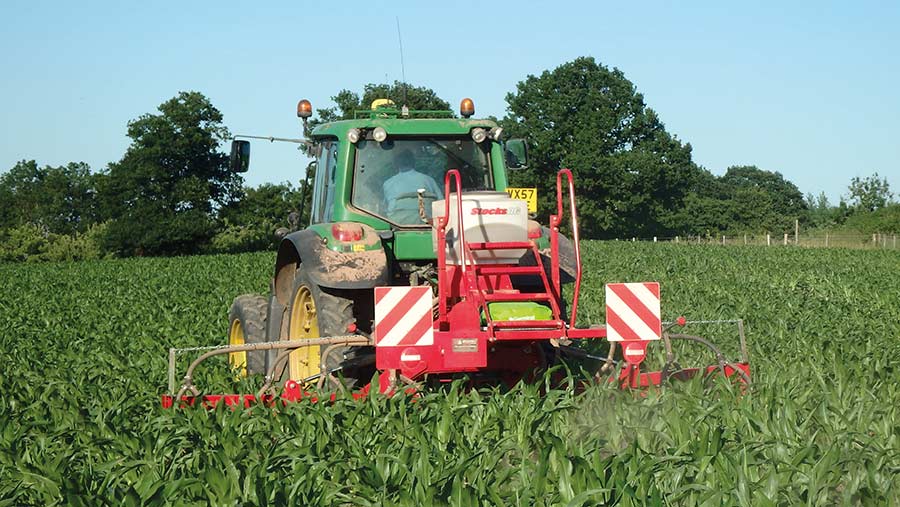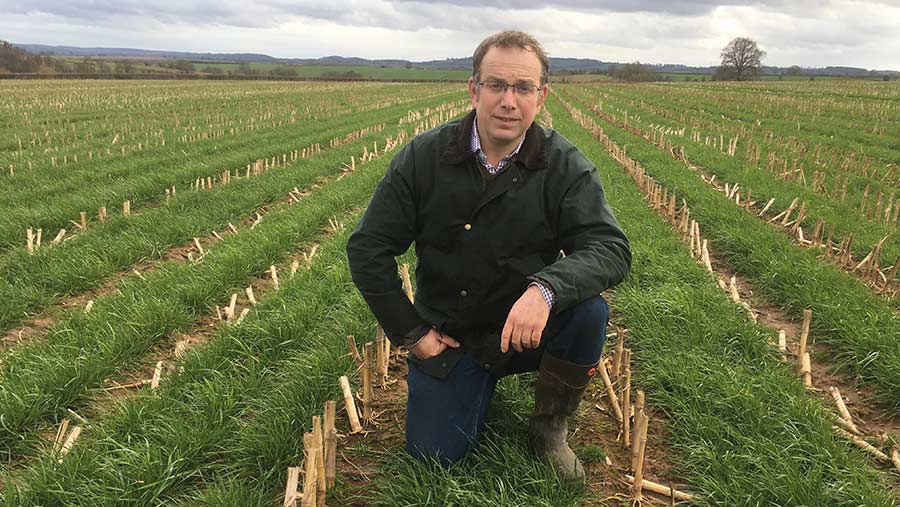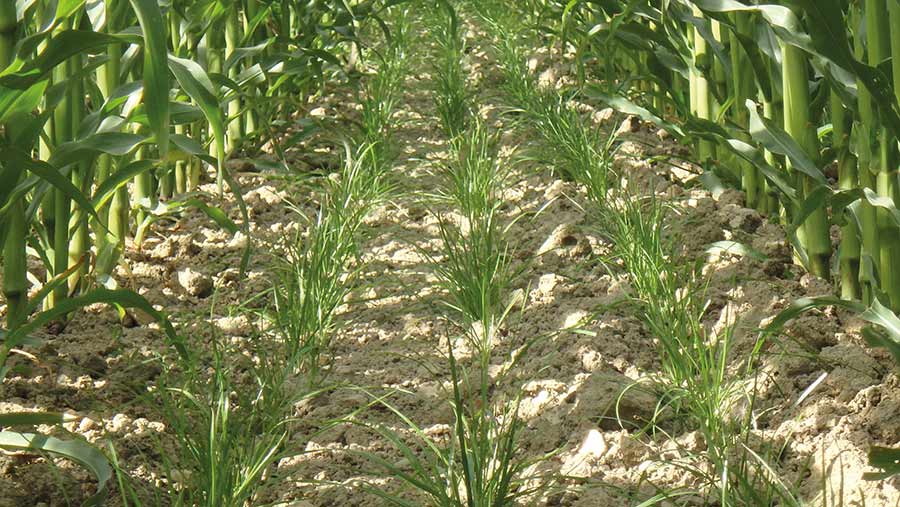How maize undersown with grass provides two-fold benefit
 © Francis Dunne Field Options
© Francis Dunne Field Options For the past six years, David Pursey has undersown maize with Italian ryegrass to protect against soil erosion and provide a post-lambing spring bite for ewes and lambs.
“We decided to undersow to make better use of nutrients by trying to reduce leaching and soil erosion over winter.
It allows us to graze more stock and I definitely think the livestock helps the soil biology, too,” he explains.
See also: How undersowing maize with grass can cut N leaching
He also believes the Environment Agency will likely increase pressure on maize growers not to leave stubbles bare over winter because of erosion risk, adding: “Washing your topsoil away can’t be a good move.”

David Pursey © Amy Pursey
Farm facts: Trevase Farm, Ross-on-Wye, Herefordshire
- 364ha (900 acres) across two farms
- 80 dairy-cross British Blue suckler cows, currently being bred to Stabilisers
- Bazadaise bull used as terminal sire
- Heifers sold as stores and bull calves finished at 12-16 months old
- 600 ewes – including 500 Suffolks and 100-120 Mules
- All lambs finished and sold liveweight
- Supplies Avara with broilers
- 499kW anaerobic digester
Mr Pursey grows maize predominantly as an energy crop for a 499kW anaerobic digester. About 5% is fed to cattle and sheep.
The flock is fed maize silage as part of a total mixed ration (TMR) in the run-up to lambing and then afterwards in troughs. Heifers also receive it as part of a TMR.
An additional 5% is dried for use as bedding in broiler housing.
A total of 162ha (400 acres) of maize is grown, usually in rotation with wheat. Fields that are to be put into maize for two consecutive years before moving to wheat are selected for undersowing with grass. These make up 40-53ha (100-130 acres) annually.
How maize is undersown at Trevase Farm
- The preceding crop, which could be anything from grass to stubble turnips or wheat stubbles, is burned off with glyphosate
- Digestate is applied at 35cu m/ha (14cu m/acre), depending on soil analysis
- Ground will be ploughed, subsoiled and power-harrowed
- The maize is drilled at 105,000 seeds/ha (42,500 seeds/acre) from April to May
- 150-250 litres/ha (61-101 litres/acre) of liquid fertiliser is applied pre-emergence depending on field requirements
- A contact herbicide is then used
- 10-14 days later the grass is drilled by a contractor using a Weaving disc drill – a specialist inter-row drill. At this point the maize is “welly height”
- The crop is then left, and the maize usually harvested in September
Maize selection
Maize is drilled in April to May, depending on specific fields. Maize varieties are selected based on drilling date and field, regardless of undersowing,
The main, early-drilled crop tends to include varieties with a Food and Agriculture Organisation (FAO) maturity rating of 180-200 heat units.
Varieties with a lower rating (early-maturing) of about 160 heat units will be selected for crops to be drilled later.
Grass selection
As the grass is a short-term ley, which will only be used for grazing the following spring, before the field is reseeded with maize, Mr Pursey uses Italian ryegrass for undersowing.
“We’ve had good results. You get decent yields and it has vigour, so it establishes well,” he says.

© Francis Dunne Field Options
How is the grass used?
Grass is mainly used for grazing with ewes and lambs after lambing in February.
After the maize is harvested, the grass may also be grazed with ewes before Christmas if there is sufficient growth.
Fertiliser or digestate may be applied in the spring, depending on how much forage is required.
Mr Pursey says deciding how long the grass should be grazed for and when it should be burned off for the following maize crop to be established is a balancing act.
Leaving maize drilling too late after the first year of grass can compromise maize yields (see “Top tips for undersowing maize with grass”).
“You would have to leave the grass pretty late into May to cover the costs of the drilling and the seed and to get an effective grazing return,” he adds.
He aims to burn off the Italian ryegrass before 10 May and then repeat the process of undersowing maize with grass in the second year.
He has tried growing crops such as forage rye and spring oats after maize harvest, but he found nothing works as well or is as cost-effective or reliable as undersowing with grass.
He is committed to continuing to undersow maize with grass.
“It is improving soil health. [The soil] is more friable and better structured – whether that’s because of the grass or the livestock, I don’t know,” he says.
“It has also given us some grazing at a time when we need it. It allows us to use resource, whether that’s phosphorus, potassium and nitrogen in the soil, or grazing. It’s allowing us to be more efficient.”
David Pursey’s top tips for undersowing maize with grass
- Timeliness of spraying and drilling is crucial Get organised with contractors. To avoid damaging the crop, the maize should be no taller than knee height when the grass is drilled.
- Choose early-maturing maize varieties This will allow maize to be drilled in May to give more grass grazing days, and still be harvested in September.
- Don’t wait to get more grazing out of the grass in the second year The maize is the priority crop, not the grass, so it’s a balance between grazing days and maize yields.
- Maize yields could be affected in smaller fields. There will be headland damage when the maize is undersown, so yields may be affected in small, awkward-shaped fields. In fields of 4ha (10 acres) and bigger, damage is minimal and maize yields shouldn’t be affected.
- Be aware of moisture conservation in the second year. If the undersown grass is sprayed off after 10-15 May, prior to maize being drilled again, maize germination can be challenged by grass taking moisture out of the ground. One year, this resulted in a 50% drop in maize yields at Trevase Farm.
